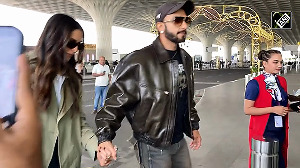'In a world which is full of categories, hatred and ideologies, there was this basic decency.'

In the summer of 2020, Basharat Peer, who was working with The New York Times, saw a photograph that was being shared on social media.
In the photograph, a young man was seated next to a highway. He was holding another man, who appeared to have fainted, in his lap.
The two men were part of the millions of Indians, who trekked across the country to head back to their homes during the first wave of COVID and lockdown.
Basharat was so moved by the photograph that he decided to travel through Uttar Pradesh in search of the two men, Mohammad Saiyub, and his childhood friend Amrit Kumar, who had collapsed from heatstroke when the picture was taken. What made the story even more compelling was that Saiyub was Muslim and Kumar a Dalit.
Eventually, Basharat wrote a story about his journey and the tragic circumstances connected with the photograph. His piece Taking Amrit Home ran in The New York Times' Sunday Opinion section on July 31, 2020.
A year later, Basharat met his friend Somen Mishra, head of creative development at Dharma Productions, in Mumbai. During the conversation, Mishra asked Basharat if the rights to the article were available.
Basharat was intrigued, since Dharma -- under the leadership of Karan Johar -- was known for big budget Bollywood films such as Kuch Kuch Hota Hai and Kabhi Khushi Kabhie Gham. But Mishra informed him that filmmaker Neeraj Ghaywan (Masaan) was moved by the story and wanted to make it into a film.
Basharat visited the Dharma office in Mumbai and met with Apoorva Mehta, CEO of the production house. Later, he also met with Ghaywan in Delhi.
The rights for Basharat's story were with The New York Times; he had left the newspaper by then.
So Dharma negotiated with the company directly to secure the rights. The Times' rules state they would not share royalty with a former employee, even if he had written a piece. So Basharat got no compensation from the deal.
Ghyawan's film Homebound inspired by Basharat's article, and starring Ishaan Khatter, Vishal Jethwa and Jahnvi Kapoor, premieres in the Un Certain Regard section at the Cannes film festival on May 21.
In addition to Johar and Mishra, the film has the backing of Martin Scorsese, who has come on board as an executive producer of the film.
Basharat, who earlier co-wrote the screenplay of Haider (2014) with Vishal Bhardwaj, is not planning to travel to Cannes. But he is glad that a film has been made inspired by his article. It should help him with his future film writing projects.
"It was the dignity of the journey that moved me," Basharat tells Aseem Chhabra. "When a truckwalla saw Amrit was coughing, he said, 'He is sick, so it is best to leave him behind.' Saiyub said, 'No, I cannot leave him behind.' When he told me that story, I said to him, 'In this mad world, you're a hero'."
Basharat, while working on the story, did you ever think that it could get made into a film?
I wouldn't have thought of it.
I just wrote a story; I wasn't trying to write a screenplay.
I saw this hazy photograph on Twitter of two young men, and one is holding the other, cradling him, almost like a mother, on some highway in the middle of nowhere. It was such an arresting image.
I was working as the international opinion editor at the Times.
I first thought of commissioning someone to do a piece on this. Then I thought I had to do it myself. I had to meet the families and get a sense of the world the two men came from.

Where were you based at that time?
London. But the office had shut down during COVID, so I had come to Delhi.
Did you find out who took the photograph?
Nobody knows that. Some stranger took a cell phone photograph and put it online. The poor guy (Saiyub) was stressed. He had no idea someone took the picture.
But in a world which is full of categories, hatred and ideologies, there was this basic decency. There was something beautiful about the two people. It reminded me of John Steinbeck's Of Mice And Men. I called a few people, a couple of reporters helped and found out the village the two were from.
The photograph was taken in Madhya Pradesh.
The two men were traveling from Surat to their village Devari, which is in UP, half an hour away from Ayodhya.

As a journalist, did you know the area well?
I went to college in UP (Aligarh Muslim University). I had traveled, reported all across North India.
But this situation was not about one particular government. Okay, the lockdown was Modi's decision, but one can't blame him for the reason millions of people had to walk back home.
That's a structural problem that goes way deeper in India.
Every government that has ever run India is responsible for that.
That is why going to the village and spending time there was important for me.
In every city across India, you will find chowkidars, construction workers and rickshaw wallas from UP and Bihar. The bulk of India's economic engine, all your industries, are by the coasts, whether it is the southern states or Maharashtra. Then there's this Delhi/NCR pocket in the middle. North India is essentially deindustrialised.
My story was a reminder of this fact.
You have a massive youth dividend, but where does a young person go?
Education may be a way out, but the kind of education and training they have is so limited. Kya karega bechara? Mazdoor hi to banega, na?
I had watched Muzaffar Ali's Gaman when I was writing this article. It is because of the deindustrialisation of North and Central India that these people have to leave their homes and live in these Dickensian tenements all across Gujarat and Bombay.
The COVID crisis showed us that the investments we made in health need to be ramped up in a big way. These are far bigger issues than the Hindu-Muslim narratives, since this affects everyone. One person falls sick and the entire family sinks.
In writing this story, all the concerns I had about India, things I had thought about for years came together in that one week. But the story of those two boys was the engine, their relationship and the love.

In the summer of 2020, the vaccines were not out. Were you not concerned about your health when you traveled to the village?
It was quite bad at that time when I went reporting. I talked to my editor in New York and told him I would need space, at least 3,000 to 4,000 words, maybe more.
He said, 'Go, just be careful.'
I coordinated with The New York Times Delhi bureau. They had the protective equipment. I had to go with a photographer Vivek Singh, and we hired a car.
To be honest, I was scared. But we had our masks and gloves on.
All the time?
Yes. But when I reached the village, I noticed no one was wearing masks there.

Had COVID reached there?
Yes, COVID was everywhere. But in the village, everyone was out and no one was wearing a mask. So I had to leave everything, including the face shield in the car.
I was visiting a poor family, so I just couldn't wear the protective gears.
If you had worn the mask and shield, that would have reflected your privileged background.
Yes. I sat on the floor and they offered me chai. I spent two days talking to everyone. Luckily, I didn't catch COVID. I got COVID much later.
I know rationally it was wrong to interview people without a mask. But looking into their eyes, I just couldn't do it.
They knew nothing about The New York Times or the world I came from.
I was another human being sitting with them. It was heartbreaking what these families had endured.
Tell us about the friendship between the two men, a Muslim and a Dalit. Was that normal, given the fact that both were minorities, looked down upon, especially in the village where probably the upper caste people ruled?
I think it was a friendship formed in the village. The fact that human relations took precedence over particular identities was a part of the Indian way of life. I don't think they went about it in a kind of self-conscious, intellectual way, believing they were doing the right thing by creating a coalition of the disenfranchised.
Now, in the media and the social media discourse, everything has been poisoned by an exaggerated emphasis on categories and placing people in terms of their religious or ethnic identities but human beings are complicated.
But it was the dignity of the journey that moved me.
When a truckwalla saw Amrit was coughing, he said, 'He is sick, so it is best to leave him behind.'
Saiyub said, 'No, I cannot leave him behind.'
When he told me that story, I said to him, 'In this mad world, you're a hero.'
To have the decency and care about friendship in this way.

Have you seen the film?
No. But I have heard great things. I heard Ishaan Khatter, who plays Saiyub, has done a great job.
He's a very fine actor right from the time he acted opposite Tabu in A Suitable Boy. Did you read the script? Is it faithful to your reporting?
I did read the script. I wasn't formally writing it but informally, I helped Neeraj with various things.
He had to build characters, the early lives of Saiyub and Amrit, which is fictional.
I was not writing the script, nor was I directing the film, so it was his prerogative.







